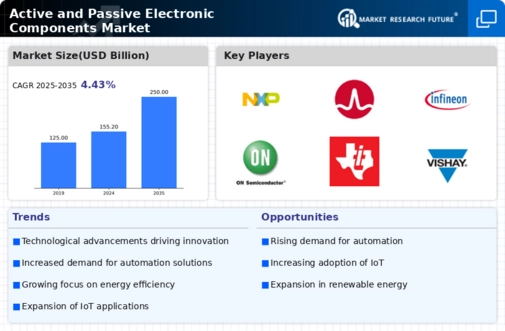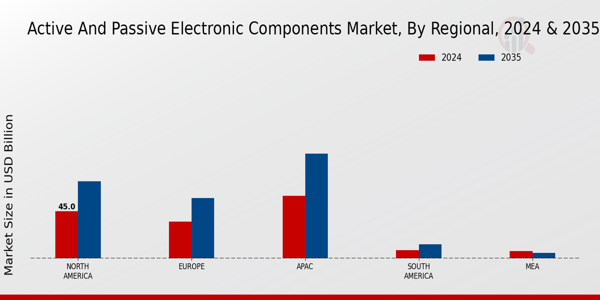Market Growth Projections
The Global Active and Passive Electronic Components Market Industry is poised for substantial growth, with projections indicating a market size of 155.2 USD Billion in 2024 and an anticipated increase to 250 USD Billion by 2035. This growth trajectory reflects a compound annual growth rate (CAGR) of 4.43% from 2025 to 2035, underscoring the industry's resilience and adaptability in a rapidly evolving technological landscape. As various sectors continue to integrate advanced electronic solutions, the market is likely to witness sustained demand, driven by innovations and the increasing complexity of electronic systems.
Increasing Adoption of IoT Devices
The rise of the Internet of Things (IoT) significantly impacts the Global Active and Passive Electronic Components Market Industry. As more devices become interconnected, the demand for electronic components that facilitate communication and data processing is on the rise. IoT applications span various sectors, including smart cities, healthcare, and industrial automation, necessitating a diverse range of active and passive components. This trend not only enhances operational efficiencies but also drives market growth, as the need for reliable and efficient electronic solutions becomes paramount in an increasingly connected world.
Growth of Renewable Energy Solutions
The Global Active and Passive Electronic Components Market Industry is also propelled by the expansion of renewable energy technologies. Solar panels, wind turbines, and energy storage systems require a variety of electronic components to optimize performance and efficiency. As governments and organizations worldwide prioritize sustainability, the demand for these components is likely to increase. This shift towards renewable energy not only supports environmental goals but also stimulates economic growth within the electronic components sector. The integration of advanced electronics in energy solutions could further enhance market dynamics, aligning with the projected growth figures.
Advancements in Automotive Electronics
The automotive sector significantly influences the Global Active and Passive Electronic Components Market Industry, particularly with the rise of electric and autonomous vehicles. These vehicles rely heavily on advanced electronic components for functionalities such as battery management systems, infotainment, and safety features. As automotive manufacturers increasingly adopt electronic solutions, the demand for both active and passive components is expected to grow. This trend is indicative of a broader shift towards smart transportation solutions, which could drive the market's growth trajectory, contributing to the anticipated CAGR of 4.43% from 2025 to 2035.
Rising Demand for Consumer Electronics
The Global Active and Passive Electronic Components Market Industry experiences a surge in demand driven by the proliferation of consumer electronics. Devices such as smartphones, tablets, and smart home appliances require a multitude of electronic components, both active and passive, to function effectively. In 2024, the market is projected to reach 155.2 USD Billion, reflecting the increasing integration of technology into daily life. As consumer preferences evolve towards more sophisticated gadgets, manufacturers are compelled to innovate, thereby expanding the market further. This trend is expected to continue, with the market potentially reaching 250 USD Billion by 2035.
Technological Innovations in Electronics
Technological advancements play a crucial role in shaping the Global Active and Passive Electronic Components Market Industry. Innovations such as miniaturization, improved energy efficiency, and enhanced performance characteristics of electronic components are driving manufacturers to adopt new technologies. This evolution allows for the development of more compact and efficient devices, catering to the needs of various industries, including telecommunications and healthcare. As these innovations continue to emerge, they are likely to create new opportunities within the market, fostering a competitive landscape that encourages further investment and growth.
















